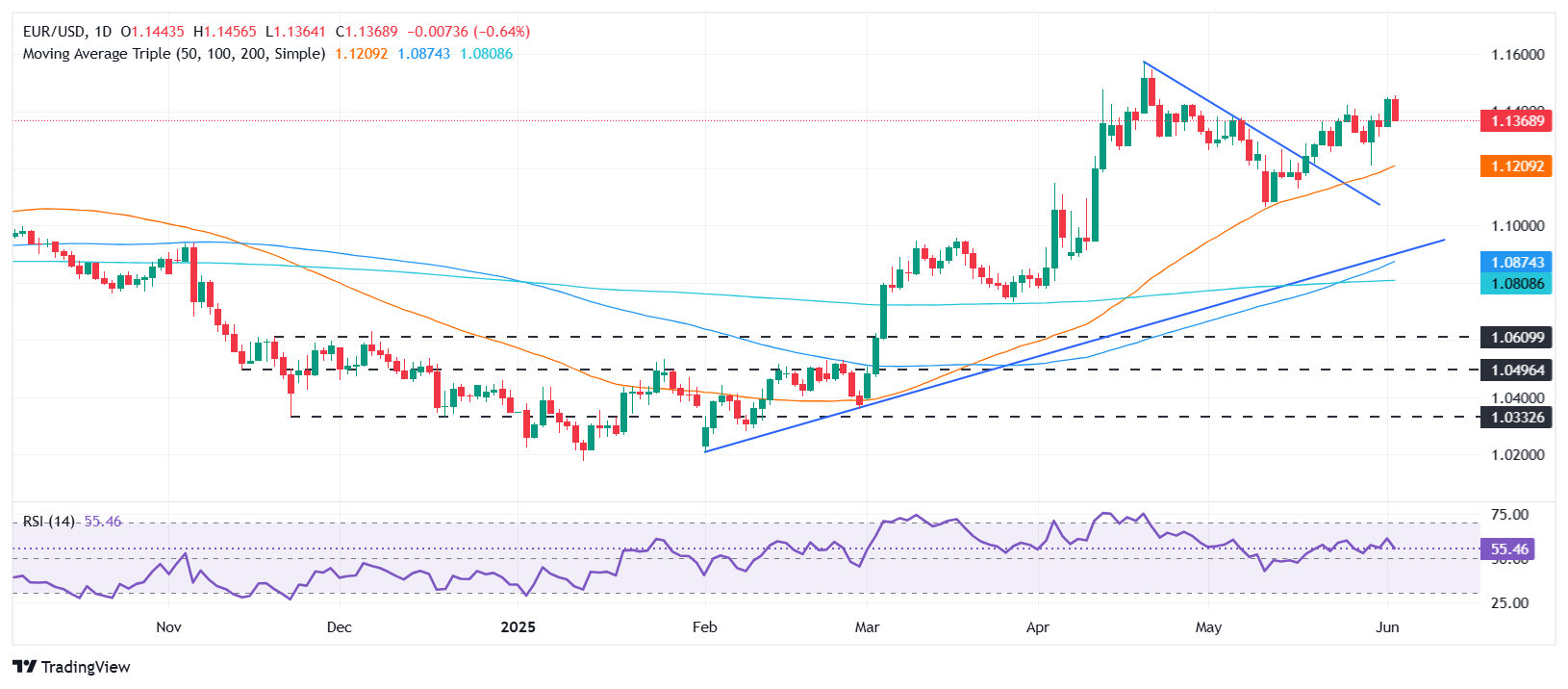Created
: 2025.06.04














![]() 2025.06.04 04:52
2025.06.04 04:52
EUR/USD retreats after hitting a six-week peak of 1.1454 on Tuesday amid increasing concerns of market participants regarding the trade war ignited by the United States (US). The Greenback's appreciation weighs on the pair, which trades at 1.1379, down 0.52%.
Wall Street remains in the green as news emerged that US President Donald Trump is reportedly set to speak with Chinese President Xi Jinping this week, according to Reuters sources.
Data from the United States lifted the US Dollar (USD), which has been battered and lost nearly 2% this week, according to the US Dollar Index (DXY). April's US Job Openings and Labor Turnover Survey (JOLTS) was better than expected, hinting that the labor market is solid. Meanwhile, Factory Orders fell sharply in April as manufacturing activity is pressured due to US President Donald Trump's tariffs.
Uncertainty about US trade policies is also a reason behind the decline of the EUR/USD pair. The White House Press Secretary Karoline Leavitt said that the trade offer deadlines can confirm the letter is authentic and on track to good deals. She added that President Trump will sign an executive order to double tariffs on steel and aluminum on Tuesday, which will take effect on Wednesday.
Across the pond, the Eurozone Harmonized Index of Consumer Prices (HICP) inflation data for May fell below the European Central Bank (ECB) objective. This reaffirms expectations that the ECB might cut rates this week, a path that began last June.
In the Eurozone, the docket will feature the European Central Bank monetary policy decision and ECB President Christine Lagarde's press conference. In the US, the schedule is packed with employment data, with the ADP National Employment Change for May awaited on Wednesday, followed by Initial Jobless Claims for the week ending May 31 and May's Nonfarm Payrolls figures.
EUR/USD is upward biased, as depicted by the daily chart, despite the ongoing pullback. The Relative Strength Index (RSI) is bullish, but it begins to show signs that it's losing steam, opening the door for a deeper retracement.
If EUR/USD falls below the June 2 daily low of 1.1344, it could clear the path to challenge the 1.1300 level. A breach of the latter would expose the 20-day Simple Moving Average (SMA) at 1.1278, followed by the 50-day SMA at 1.1218. On further weakness, expect a test of 1.1200.
Conversely, if EUR/USD climbs past 1.1400,buyers could test the weekly peak of 1.1454, followed by the April 21 year-to-date (YTD) peak at 1.1573.

The Euro is the currency for the 19 European Union countries that belong to the Eurozone. It is the second most heavily traded currency in the world behind the US Dollar. In 2022, it accounted for 31% of all foreign exchange transactions, with an average daily turnover of over $2.2 trillion a day. EUR/USD is the most heavily traded currency pair in the world, accounting for an estimated 30% off all transactions, followed by EUR/JPY (4%), EUR/GBP (3%) and EUR/AUD (2%).
The European Central Bank (ECB) in Frankfurt, Germany, is the reserve bank for the Eurozone. The ECB sets interest rates and manages monetary policy. The ECB's primary mandate is to maintain price stability, which means either controlling inflation or stimulating growth. Its primary tool is the raising or lowering of interest rates. Relatively high interest rates - or the expectation of higher rates - will usually benefit the Euro and vice versa. The ECB Governing Council makes monetary policy decisions at meetings held eight times a year. Decisions are made by heads of the Eurozone national banks and six permanent members, including the President of the ECB, Christine Lagarde.
Eurozone inflation data, measured by the Harmonized Index of Consumer Prices (HICP), is an important econometric for the Euro. If inflation rises more than expected, especially if above the ECB's 2% target, it obliges the ECB to raise interest rates to bring it back under control. Relatively high interest rates compared to its counterparts will usually benefit the Euro, as it makes the region more attractive as a place for global investors to park their money.
Data releases gauge the health of the economy and can impact on the Euro. Indicators such as GDP, Manufacturing and Services PMIs, employment, and consumer sentiment surveys can all influence the direction of the single currency. A strong economy is good for the Euro. Not only does it attract more foreign investment but it may encourage the ECB to put up interest rates, which will directly strengthen the Euro. Otherwise, if economic data is weak, the Euro is likely to fall. Economic data for the four largest economies in the euro area (Germany, France, Italy and Spain) are especially significant, as they account for 75% of the Eurozone's economy.
Another significant data release for the Euro is the Trade Balance. This indicator measures the difference between what a country earns from its exports and what it spends on imports over a given period. If a country produces highly sought after exports then its currency will gain in value purely from the extra demand created from foreign buyers seeking to purchase these goods. Therefore, a positive net Trade Balance strengthens a currency and vice versa for a negative balance.
![]()
Created
: 2025.06.04
![]()
Last updated
: 2025.06.04

FXStreet is a forex information website, delivering market analysis and news articles 24/7.
It features a number of articles contributed by well-known analysts, in addition to the ones by its editorial team.
Founded in 2000 by Francesc Riverola, a Spanish economist, it has grown to become a world-renowned information website.
We hope you find this article useful. Any comments or suggestions will be greatly appreciated.
We are also looking for writers with extensive experience in forex and crypto to join us.
please contact us at [email protected].
Disclaimer:
All information and content provided on this website is provided for informational purposes only and is not intended to solicit any investment. Although all efforts are made in order to ensure that the information is correct, no guarantee is provided for the accuracy of any content on this website. Any decision made shall be the responsibility of the investor and Myforex does not take any responsibility whatsoever regarding the use of any information provided herein.
The content provided on this website belongs to Myforex and, where stated, the relevant licensors. All rights are reserved by Myforex and the relevant licensors, and no content of this website, whether in full or in part, shall be copied or displayed elsewhere without the explicit written permission of the relevant copyright holder. If you wish to use any part of the content provided on this website, please ensure that you contact Myforex.
Myforex uses cookies to improve the convenience and functionality of this website. This website may include cookies not only by us but also by third parties (advertisers, log analysts, etc.) for the purpose of tracking the activities of users. Cookie policy